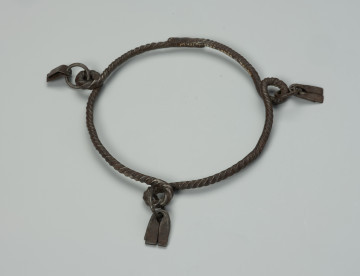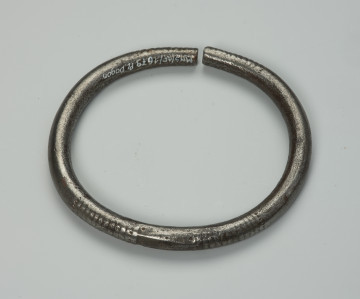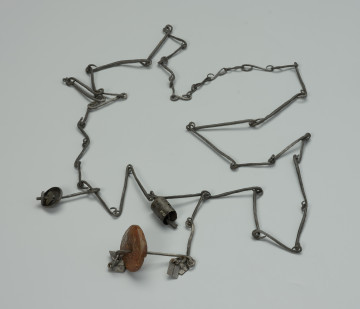
Men's bracelet
około 1940
National Museum in Szczecin
Part of the collection: Collection of Dogonian art
The children's bracelet, a rare type of amulet that a child wore on the wrist, is made up of many different parts threaded onto a cotton cord: an iron link, glass and stone beads of different sizes and colours, kauri shells and a larger shell. Each part of the bracelet has its own significance. These include the dugo (also called duge), which is a spiritual support for the wearer, a material embodiment of the bond with supernatural forces, and a sign of alliance between a human and ancestor. Dugo can take the form of a small stone, a glass bead, an iron ring or link, or a coin hung around the neck or wrist. They are inspired by nyama - the life force of the ancestors. They connect dugo-wearing women, men and children with the recently deceased, from whom they have inherited nana (reincarnation). The Dogon believe that after a person's physical death, their nana is passed on to their conceived or newborn offspring - women receive the nana of female ancestors and men receive the nana of male ancestors. Dugo is a sign of agreement and mutual obligation between ancestor and descendant. They guarantee the fulfilment of a request made by a person to supernatural forces. There is a danger that the power contained in it can turn against people if they fail to fulfil obligations to their ancestors. The power filling dugo is usually meant to protect the wearer, ensuring health, fertility and prosperity, while the wearer of dugo is obliged to revive the memory of the ancestor and nourish his/her spiritual strength.
Katarzyna Findlik-Gawron
The children's bracelet, a rare type of amulet that a child wore on the wrist, is made up of many different parts threaded onto a cotton cord: an iron link, glass and stone beads of different sizes and colours, kauri shells and a larger shell. Each part of the bracelet has its own significance. These include the dugo (also called duge), which is a spiritual support for the wearer, a material embodiment of the bond with supernatural forces, and a sign of alliance between a human and ancestor. Dugo can take the form of a small stone, a glass bead, an iron ring or link, or a coin hung around the neck or wrist. They are inspired by nyama - the life force of the ancestors. They connect dugo-wearing women, men and children with the recently deceased, from whom they have inherited nana (reincarnation). The Dogon believe that after a person's physical death, their nana is passed on to their conceived or newborn offspring - women receive the nana of female ancestors and men receive the nana of male ancestors. Dugo is a sign of agreement and mutual obligation between ancestor and descendant. They guarantee the fulfilment of a request made by a person to supernatural forces. There is a danger that the power contained in it can turn against people if they fail to fulfil obligations to their ancestors. The power filling dugo is usually meant to protect the wearer, ensuring health, fertility and prosperity, while the wearer of dugo is obliged to revive the memory of the ancestor and nourish his/her spiritual strength.
Katarzyna Findlik-Gawron
Author / creator
Dimensions
cały obiekt: height: 11,9 cm
Object type
body adornment
Creation time / dating
Creation / finding place
Identification number
Location / status

około 1940
National Museum in Szczecin

około 1940
National Museum in Szczecin

około 1950
National Museum in Szczecin
DISCOVER this TOPIC
Museum of King Jan III's Palace at Wilanów
DISCOVER this PATH
Educational path